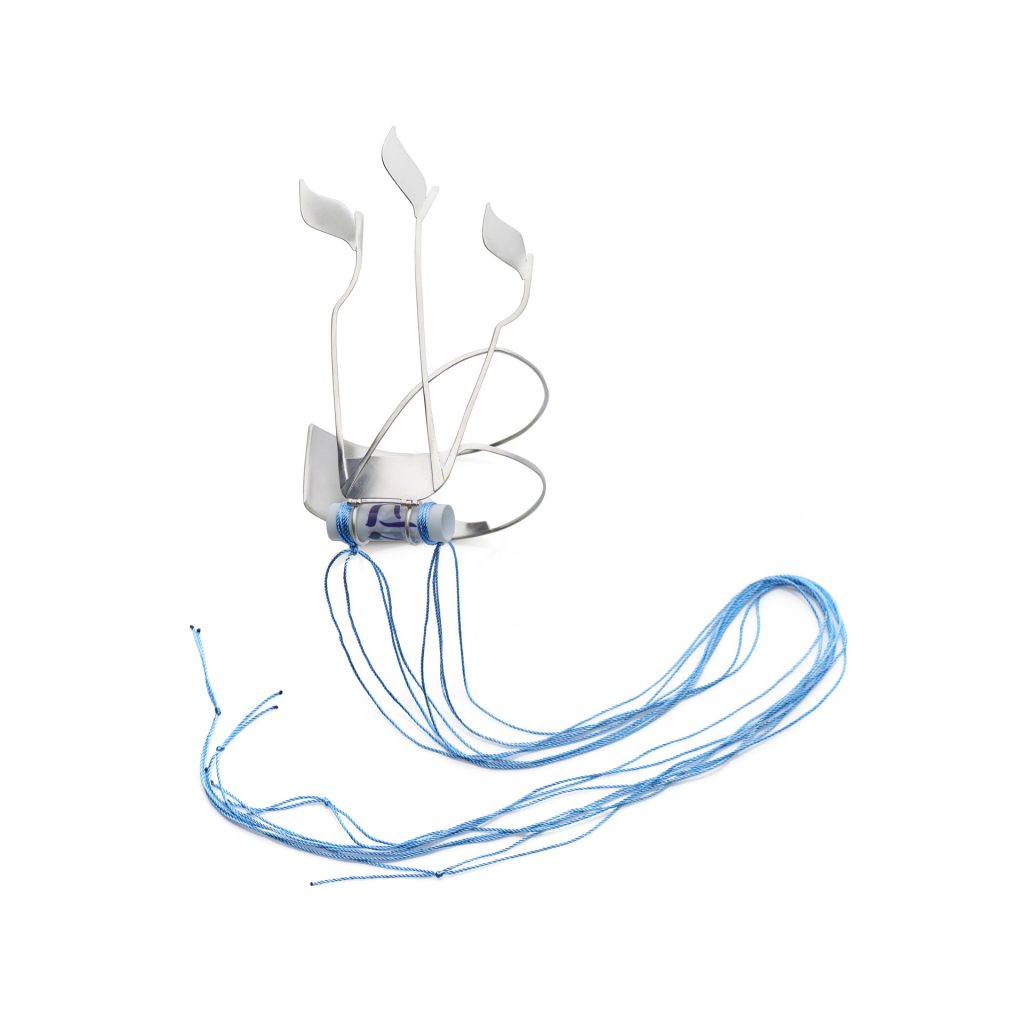Tamar Paley (b. 1991)
A Sign Upon Your Hand, Arm Tefillin 2018
Silver, acrylic string, digitally printed Mylar parchment
Museum Collection
Must Know
This arm bracelet, A Sign Upon Your Hand, suggests a new interpretation and a deconstructed version of the traditional Tefillin, a ritual object typically worn by men during weekday morning prayers. Tefillin are the physical and material embodiment of the command “And you shall bind them as a sign upon your arm, and they shall be as totafot between your eyes” (Deuteronomy 6:8), the origin of this ritual object, prominently known for its mention in the blessings of the “Shema” prayer .The traditional tefillin enclose scrolls of parchment inscribed with the paragraphs of the Shema inside two black boxes, one box is worn on the forehead (as totafot between the eyes) and the other is bound to the arm through symbolic wrappings of leather straps that spell out the name and symbol of God – “Shadai”. Both boxes are also etched with the hebrew Shin, the “ot” in hebrew, or the “sign” that we are obliged to tie to our bodies and place in the gates of our homes as a token of our love and commitment to God
More Info
In this piece, I deconstructed the different elements of the arm tefillin and reassembled them in a new composition, from a contemporary and feminine perspective. The focus of this object is the “shin”, providing a more literal translation of the command to “bind them as a sign upon your arm”. The ‘sign’ is delicately placed on the forearm of the wearer, where the tefillin box would traditionally be located. The design of the letter is based on classic hebrew calligraphy, as a reference to and a continuation of biblical and Judaic visual culture. The silver bands that stem out of the stylized letter, turn the aggressive leather straps into gentle forms that wrap and compliment the feminine form.
Beneath the shin, a scroll inscribed with the command is set within two rings placed on a hinge, making it adjustable to the body. In contrast to the traditional scrolls enclosed within sealed boxes, here the parchment is exposed, turning the text into a decorative element. Even though the letters are exposed the text remains hidden within the scroll.
Symbolic blue string wraps and fastens the scroll, echoing the wrapping and the knotting of the leather straps on the arm. The loose fringes hang freely down the wearer’s arm, touching the body in dual choreography.
The “mitzvot”, commandments, were given to all jews with no discrimination of any sex or gender. Therefore, many women across the Jewish spectrum; from orthodox to reform affiliations, chose to adopt the different rituals and their accompanying objects. Nonetheless, even today, and in the most liberal communities, those women are still usually found in the minority, and even those who do wrap in tallit or wear a kippah, find it hard to embrace tefillin. It remains the object most strange and taboo for women. Many women relate this to the overly masculine essence of the canonical straps and boxes and their bold placement.
A Sign Upon Your Hand seeks to challenge the taboo associated with women and tefillin, providing an alternative design and visibility that does not single a woman out while wearing this object in the sacred act. On the contrary, this object is designed to make a woman feel empowered and to connect her to this item which she chooses to reclaim. Paley’s work offers a reshaping of traditional patriarchal forms from a female perspective using materials, text, and symbolism that acknowledge the physical and spiritual experiences of women in Judaism.
Tamar Paley (b.1991, Jerusalem, Israel) is a Tel Aviv-based jewelry designer and artist. Paley’s creations are often a reaction to social and political subjects.

